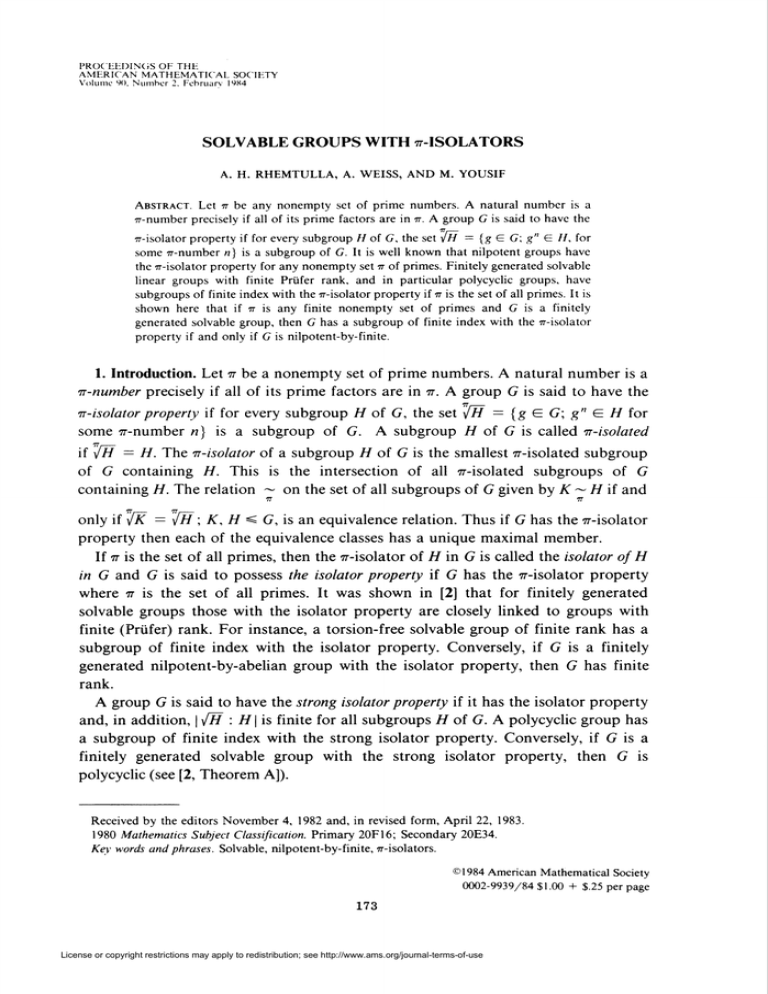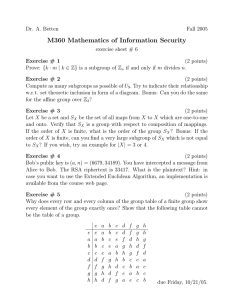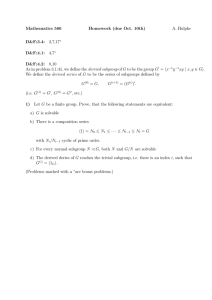solvable groups with 77-isolators
advertisement

PROCEEDINGS OF THE
AMERICAN MATHEMATICAL SOCIETY
Volume 90. Number 2. February 1984
SOLVABLE GROUPS WITH 77-ISOLATORS
A. H. RHEMTULLA, A. WEISS, AND M. YOUSIF
Abstract.
Let 77be any nonempty set of prime numbers. A natural number is a
77-number precisely if all of its prime factors are in 77.A group G is said to have the
77—
77-isolator property if for every subgroup // of G, the set iH = {g G G; g" G H, for
some 77-number «} is a subgroup of G. It is well known that nilpotent groups have
the 77-isolator property for any nonempty set 77of primes. Finitely generated solvable
linear groups with finite Prüfer rank, and in particular polycyclic groups, have
subgroups of finite index with the 77-isolator property if 77is the set of all primes. It is
shown here that if 77 is any finite nonempty set of primes and G is a finitely
generated solvable group, then G has a subgroup of finite index with the 77-isolator
property if and only if G is nilpotent-by-finite.
1. Introduction. Let 77be a nonempty set of prime numbers. A natural number is a
tr-number precisely if all of its prime factors are in 77. A group G is said to have the
77.-
■n-isolator property if for every subgroup H of G, the set i H = {g G G; g" G H for
some 77-number n) is a subgroup of G. A subgroup H of G is called -n-isolated
77.-
if v7/ = H. The m-isolator of a subgroup H of G is the smallest 77-isolated subgroup
of G containing H. This is the intersection of all 77-isolated subgroups of G
containing H. The relation ~ on the set of all subgroups of G given by K ~ H if and
77
77,-
77
71.-
only if va = i H ; K, H < G, is an equivalence relation. Thus if G has the w-isolator
property then each of the equivalence classes has a unique maximal member.
If 77is the set of all primes, then the 77-isolator of H in G is called the isolator of H
in G and G is said to possess the isolator property if G has the 77-isolator property
where 77 is the set of all primes. It was shown in [2] that for finitely generated
solvable groups those with the isolator property are closely linked to groups with
finite (Prüfer) rank. For instance, a torsion-free solvable group of finite rank has a
subgroup of finite index with the isolator property. Conversely, if G is a finitely
generated nilpotent-by-abelian group with the isolator property, then G has finite
rank.
A group G is said to have the strong isolator property if it has the isolator property
and, in addition, | -fH : H \ is finite for all subgroups H of G. A polycyclic group has
a subgroup of finite index with the strong isolator property. Conversely, if G is a
finitely generated solvable group with the strong isolator property, then G is
polycyclic (see [2, Theorem A]).
Received by the editors November 4, 1982 and, in revised form, April 22, 1983.
1980 Mathematics Subject Classification. Primary 20F16; Secondary 20E34.
Key words and phrases. Solvable, nilpotent-by-finite,
77-isolators.
©1984 American Mathematical Society
0002-9939/84 $1.00 + $.25 per page
173
License or copyright restrictions may apply to redistribution; see http://www.ams.org/journal-terms-of-use
174
A. H. RHEMTULLA, A. WEISS AND M. YOUSIF
If G is nilpotent (or even locally nilpotent) then it has the 77-isolator property for
every nonempty set 77of primes. On the other hand, if a finitely generated solvable
group G has //-isolator property for every prime p, then G is necessarily nilpotent.
This follows from three observations, (i) A finite group of this type is nilpotent. (ii)
If a finitely generated solvable group is not nilpotent then it has a finite quotient
which is not nilpotent (see [3, Theorem 10.51]). (iii) The 77-isolator property is
quotient closed. In this paper we investigate solvable groups G which have the
77-isolator property for some finite (nonempty) set 77 of primes. It would be
conceivable that polycyclic groups would perhaps have this property. The answer is
to the contrary and our main result is the following.
Theorem A. Let m be a nonempty finite set of primes, and let G be a finitely
generated solvable group. Then G has a subgroup of finite index possessing the
■n-isolator property if and only if G is nilpotent-by-finite.
2. Proofs. The proof of Theorem A is not direct. We find it desirable to start with
the following key lemma. If 6 ¥= 0 is algebraic over Q, let Z( 6 > denote the subring
of Q(0) generated by 1, 6, 0'\ Define the group Te as the semidirect product of
additive groups Z<0>, Z. Thus Te = Z<0>XI Z, and
(«,«)•
(ß,m)
= (ct + 6"ß,n + m);
a, ß G Z(0),
n, m G Z.
Key Lemma. // 77 is a finite set of prime numbers so that T$ has the -n-isolator
property, then either
(a) 77is empty, or
(b) 6 is a root of unity.
Proof. Suppose, by way of contradiction, that Tg has the 77-isolator property, 6 is
not a root of unity, and 77has a largest element q. For k > 1 put
a, = 1 +ek■ + e2k + ••■ +*«-»*=
e "~ x ^0
inz(0).
The prime divisors P of Q(#) have corresponding absolute values
norm(P)
I« /■
°r F " ,
P non-Archimedean,
\a\,
P real,
\a\ ,
P complex,
normalized so that the Product Formula holds:
nil«||/>=l
p
forO^a GQ(0).
Since 6 is not a root of unity it has height
H= II max(l,||ff||p)> 1
p
License or copyright restrictions may apply to redistribution; see http://www.ams.org/journal-terms-of-use
175
SOLVABLE GROUPS WITH 77-ISOLATORS
(see, for example, Theorem 8 on p. 77 of [4]). Consider the following classes of prime
divisors of Q(#):
Sx : Archimedean primes,
Se: P G Sx soord/,0^0,
S„: P $ Sx U Sg so P lies above some/7 G 77.
Then 5 = Sx U Sg U S„ is finite and for e > 0 we claim
\\Xk\\Yk
max(l
i= 1
for P G 5 and all k,
HÖH )<?_1 (. ** ' — e
for f G 5 and infinitely many rV.
The lemma is an immediate consequence since the claim shows that
Tí
\\Ak\\p
-^
n —^^—r^0-£)c
»'"'
/,
xcardS
7 max(l,||Ö||/,)""1
for infinitely many k, holds for each e > 0. Clearly, we may choose e > 0 to
contradict H > 1 so it remains only to verify the claim.
Suppose P G S: since \\0\\P = 1 and Xk G Z(Ö), we need only rule out the
possibility that ord,, Xk > 0. If this was the case then \k is in the ideal P0 = {a G
Z<0>: ordpa > 0} of Z<0) so (Xk, kq) is in the subgroup H = P0X A^Z of r9. By
(0,-Ar)« = (0,-kq), (1, Jt)? = (\k, kq) both (0,-/fc), (1, k) are in y77 and since this is
77.—
a group, by hypothesis, it follows that (1,0) = (1, k)(0, -k) is in yH. This means
that (N,0) = (1,0)" is in H n Z(6)=
> 0 contrary to P G 5.
P0 for some 77-number N, hence that ordf N
Suppose P G Se: here the claim follows for all /c ^ 1 from
1 — nkq
xk=-—-—
k
j _dk
1 — o~kq
if||0||/><i
11 11
and xft
= •*<*-•>-\-e~k
k
if\\e\\P>\.
"
Suppose P G Sw: it suffices to show that there is a constant aP depending only on
P (and 0) so that
(*)
oraP{0k - \)<aP
+oràP(k)
for all k > 1.
For then
IIX \\vk
\\Kk\\p
ßkq
_
!
0k - 1
l/A
\ek«-
'/* -> „^„^t
\\\V>norm{py
D\-(aP
+ ordr(kq))/k
which is > 1 — e for all large enough k.
So let p be the prime number below P, set eP = ordP(/7) > 0 and choose an
integer ëP > eP/p — 1. Denoting also by P the maximal ideal of the local ring A at
P, then A/Pep is a finite ring and 6 + Pep is a unit of A/Pep so there is a least
integer gP with f?8'' = 1 mod Pep. Setting aP = ord/>(0g'' — 1) 3* e>, an easy induction (using the binomial expansion of (1 + 6gpP' — \)p) shows that orâP{6Sppl — 1)
= aP + ePj for j 3* 0. For general k we have ord^f?* — 1) < ¿>(< aP) unless gP
divides k when we can write k = gPpJk0 with p \ k0: then (*) follows from ePj «£
ord^Â: and ord^fl* - 1) « ordP(6gppJ - 1).
License or copyright restrictions may apply to redistribution; see http://www.ams.org/journal-terms-of-use
176
A. H. RHEMTULLA, A WEISS AND M. YOUSIF
Suppose P G Sx : for z G C we have
hm
*-oo
z* — 1
Putting S* = {P G 500:||Ö||P=
hm
A-oo
,/,
[|z|,
= ■{,
'
[1,
if|z|>l,
lf|z|<l.
1}, we have
A^ljj» = hm —-——
A—00 Ho* -
l\\yk
= max(l, 0 ,,)*
for P G S*, again verifying the claim for a// large k.
Finally, each ?£5,
defines a monomorphism Q(0) -» C so that 0 -» e2v">p for
some <i>pG R/Z. Now setting (x)= minmez|x — m\ for real x defines a function
R/Z -» [0, {]. Since S„ is finite, Dirichlet's theorem on simultaneous approximation
shows that there are infinitely many k so that
0<(k<j>p)<—
for all P G S„
and then, clearly, (qk<¡>P)= q(k<¡>P). Then by the identity
\e2"ix - 1 |2 = 4 sin2 ir(x),
x G R/Z,
we get
/ sin77(4/^)
11 ^
\2^
\ sin77(k<t>P) j
/277-1
\
--nq^p)
\2
_ /2?\
-n(k<i>P)
j
"\
77 J
2
> 1
for all P G S^ and infinitely many k. This verifies the claim and concludes the proof
of the lemma.
Remark. By using the Tchebotarev Density Theorem it is possible to prove the
lemma also for some infinite sets 77,namely those of small (upper) Dirichlet density.
Proof of Theorem A. Let 77be a nonempty finite set of primes and G a finitely
generated solvable group with the 77-isolator property.
Case 1. Suppose G is polycyclic. We may assume, if necessary, that G has a finite
series with infinite cyclic factors. Using induction on the length of this series we may
assume that G = (N, t), where N is a nilpotent-by-finite normal subgroup of G. If
G is not nilpotent by finite, there is a section of G of the form / = (a, t) where
(aJ)=A
is abelian, J —A X (t), and / is not nilpotent-by-finite. By the Key
Lemma, J does not have the 77-isolator property. This gives the required contradiction.
Case 2. Reduction to Case 1. We will use induction on the solvability length of G.
If G is abelian then we are done. Let G be solvable of length d + 1 and assume the
result holds for groups of length d(d> 1). Let A = G{d),the dth term of the derived
series. Then G/A is polycyclic-by-finite, and by replacing G with a subgroup of
finite index, if necessary, we may assume that G/A is polycyclic. Then by the
well-known result of P. Hall (see [1]), G satisfies max-«, the maximal condition on
normal subgroups. If G is not polycyclic, then there exists a G A and t G G such
that (aJ) is not finitely generated where / = (a, t). This group is abelian-by-cyclic.
We may assume G = (a, t) and A — (ac). If the Prüfer rank of A is not finite,
License or copyright restrictions may apply to redistribution; see http://www.ams.org/journal-terms-of-use
177
SOLVABLE GROUPS WITH 77-ISOLATORS
then G has a section ( b ) wr ( / ) isomorphic to the wreath product Cp wr Cx where p
is a prime and Cn denotes the cyclic group of order n. But the group (b) wr (t > does
77,-
not have the 77-isolator property as can be seen by taking \JH where H = (t) if
p G 77 and H = (b, tq) if /? £ 77 where q is any prime in 77. Conclude that
G= (a,t)
has finite rank. Now if A is periodic, then it is finite and G is
nilpotent-by-finite. We can now invoke the Key Lemma to eliminate the remaining
case. This leaves us with the case G is polycyclic and we are in Case 1.
The converse is immediate from P. Hall's result that a nilpotent group has the
77-isolator property for all 77.
References
1. P. Hall, Finiteness conditions for soluble groups, Proc. London Math. Soc. (3) 4 (1954), 419-436.
2. A. H. Rhemtulla and B. A. F. Wehrfriu, Isolators in soluble groups of finite rank, Rocky Mountain J.
Math, (to appear).
3. D. J. S. Robinson, Finiteness conditions and generalized soluble groups. Part 2, Springer-Verlag, Berlin
and New York, 1972.
4. A. Weil, Basic number theory, Springer-Verlag,
Department
of Mathematics,
University
Berlin and New York, 1967.
of Alberta,
Edmonton, Canada, T6G 2G1
License or copyright restrictions may apply to redistribution; see http://www.ams.org/journal-terms-of-use



